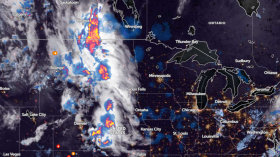Using a fairly common nonmetallic solvent, researchers have developed a superconductor capable of transmitting electrical currents without any of the resistance seen in conventional conductors.
Because the field of superconductivity has such a wide variety of potentially game-changing applications, including powerful electromagnets, vehicle propulsion and more efficient power transmission, the researchers behind the discovery believe it will pique the interest in a number of fields of study.
"It is an important discovery that will attract a lot of attention from many scientific communities - physics, chemistry and materials science," Choong-Shik Yoo, a professor in chemistry and in the Institute for Shock Physics at the University of Washington, said in a press release.
The story began three years ago when Yoo used super-high pressures similar to those found deep in the Earth to turn a white crystal into what he called "the most condensed form of energy storage outside of nuclear energy."
Yoo saw how carbon disulfide subjected to high pressure and cold started to act like a metal, taking on properties like magnetism, high-energy density and super-hardness as its molecules reassembled in three-dimensional structures similar to those found in diamonds.
Normally, nonmetallic molecules are too far apart from each other for electrical energy to move across them. However, Yoo and his colleagues, including researchers at the Carnegie Institution of Washington, compressed the compound in the small space of a diamond anvil cell to 50,000 atmospheres - the same amount of pressure found 600 miles deep inside. Meanwhile, they chilled the compound to 6.5 degrees Kelvin, or nearly -447 degrees Fahrenheit.
As they did this, the pressure and temperature brought the carbon disulfide molecules together and rearranged them into a lattice structure in which the natural vibrations of the molecules helped electrons move so well that it essentially became a resistance-free superconductor.
Ultimately, the research provides new insight into how superconductivity works in unconventional materials - an area that has long intrigued scientists, Yoo said, due to the fact that they are typically made of atoms with lower atomic weights that let them vibrate at higher frequencies, increasing their potential as superconductors at hotter temperatures.
While Yoo acknowledges that electronic materials are not likely to be cooled to near absolute zero or subjected to extreme pressures, he argues that this work could lead to the creation of similar properties under more ordinary conditions in the same way that science paved the way to make synthetic diamonds at lower temperatures and pressures.
"This research will provide the vehicle for people to be clever in developing superconductors by understanding the fundamentals that guide them," he said.
© 2024 NatureWorldNews.com All rights reserved. Do not reproduce without permission.



![Saber-Toothed Cat Called 'Homotherium' May Have Roamed Submerged Continental Shelf Between Texas and Florida At Least 12,000 Years Ago [Study]](https://1471793142.rsc.cdn77.org/data/thumbs/full/70705/280/157/50/40/saber-toothed-cat-called-homotherium-may-have-roamed-submerged-continental-shelf-between-texas-and-florida-at-least-12-000-years-ago-study.jpg)

